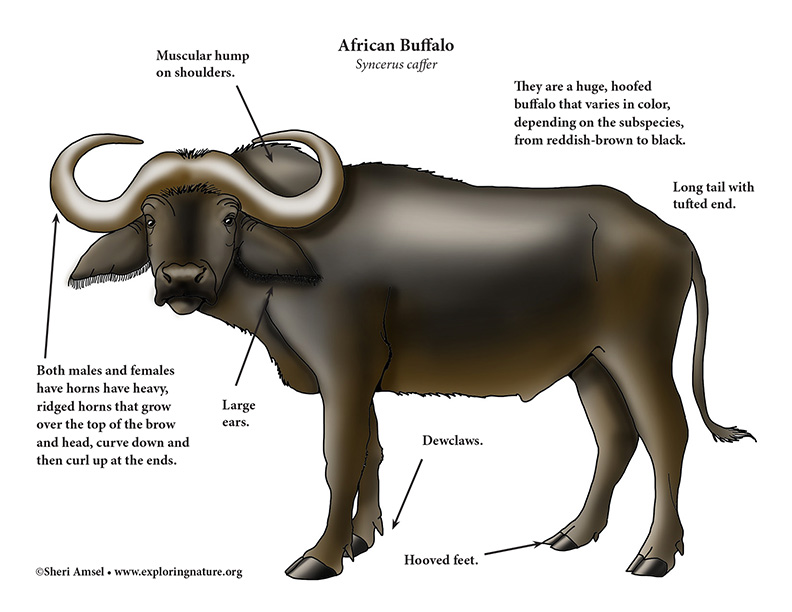

They are found in sub-Saharan Africa. Their numbers have been greatly reduced in the last century. There are four subspecies that inhabit different regions of Africa. The Cape Buffalo (Syncerus caffer caffer), Central Africa Savannah Buffalo (Syncerus caffer aequinoctialis), West Africa Savannah Buffalo (Syncerus caffer brachyceros), and Forest Buffalo (Syncerus caffer nanus).
They can live in any kind of habitat as long as it has a year round source of water and grass. The different subspecies live in grasslands, forests, rainforests, and bushland. They are not found in the desert. Their numbers have declined in all their habitats and they are most often found in wildlife preserves.
They are a huge, hoofed buffalo that varies in color, depending on the subspecies, from reddish-brown to black. Size and horn shape varies by the subspecies as well. The Cape Buffalo has heavy, ridged horns that grow over the top of the brow and head, curve down and then curl up at the ends. It can reach 130 cm wide. Both males and females have horns. Males are much bigger than females. Male Cape Buffalo can weigh more than 1,700 pounds (800kg) and reach more than five feet (160cm) at the shoulder.
They are social animals living in herds of varying numbers. There are both breeding herds of females and their young and older siblings (and some random males) and bachelor herds of all males. They don't migrate the way wildebeest do, but the herd does move around to find better grazing. They are active day and night, resting in the early morning and later in the afternoons. Males use their horns to spar for dominance, but they don't do this extensively or violently. However, when startled or threatened, they can be aggressive and very dangerous.
The eat grass. They are ruminants, with a similar digestive tract to cows. This means that after they feed on tough grass, it sits in their stomach and ferments for a period of time to soften it. Then they spit it up (regurgitate) and chew it more, before swallowing it again to complete digestion.
Lions prey on the African buffalo found on the outer edges of the herd. If predators are around, the pregnant females will move into the center of the herd for safety. Calves may fall prey to leopards, spotted hyenas, or African wild dogs.
Females are pregnant for almost a year (about 340 days). They have single young that will nurse for 9-10 months. They start grazing on plants at about about two months old. They stay with their mothers until they are between 1-2 years old. Only the females take care of the young, who are vulnerable to predators at birth. They may hide their young in vegetation until they are strong enough to keep up with the herd (within a few hours to a day or two). Other females in the herd may protect calves that get separated from their mothers.
They can live more than 20 years in the wild. Under the IUCN Red list, African Buffalo are listed as least concern. They are not endangered.
Kingdom: Animalia
Phylum: Chordata
Subphylum: Vertebrata
Class: Mammalia
Order: Artiodactyla
Family: Bovidae
Subfamily: Bovinae
Genus: Syncerus
Species: Syncerus caffer

